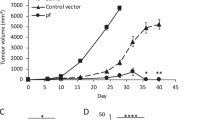Abstract
Double stranded RNA (dsRNA) whether isolated from a fungal virus or prepared synthetically (i.e., Poly I Poly C) and endotoxin were found to exert very similar effects on syngeneic murine lymphomata and fibrosarcomata. They cause complete regressions of some established subcutaneous (s.c.) or intradermal (i.d.) tumours but not of intraperitoneal (i.p.) tumours when administered either systemically or directly into the tumour. To achieve this effect the tumours must be fully established and the best results were obtained when treatment was started 7 days after transplant. If treatment is started within the first 3 days following the transplantation of the tumour then only a slight inhibition of growth rate was observed. These agents can also act prophylactically and protect mice against a subsequent challenge but only if this is given i.p. and not if given s.c. or i.d. The prophylactic action is explained by the action of dsRNA and endotoxin on peritoneal macrophages which cause them to become cytotoxic to tumour cells (i.e., to become activated).
The therapeutic effect of systemically administered endotoxin and dsRNA on established tumours is not the result of a direct action on the tumour cells themselves but is a complex process requiring the co-operation of several host factors. Haemorrhagic necrosis involving coagulation is essential (i.e., heparinization reduces the regression of tumours) but is not itself sufficient. Immunosuppression by whole body irradiation or by antilymphocyte serum also interferes with the antitumour action of dsRNA and endotoxin in spite of the fact that haemorrhagic necrosis still occurs. Also, the magnitude of the antitumour action correlated in a series of different tumours with their antigenicity. The observed tumour regressions are probably brought about by (1) vascular damage in the tumour which permits immune defence mechanisms of the host to gain access to the tumour and (2) activation of macrophages present within the tumour. The relative contribution of these two mechanisms may depend on the nature of the tumour and the route of administration of the active agents.
Dibenyline, which protects against the lethal action of endotoxin by preventing the action of the catecholamines on the α-adrenergic receptors, makes it possible to increase the effectiveness of endotoxin in tumours by allowing a large dose to be given. Lipid A, a derivative of endotoxin which does not contain polysaccharide, has similar antitumour action to dsRNA and endotoxin. Some common features of the chemical structure of lipid A and dsRNA are discussed.
Similar content being viewed by others
Rights and permissions
About this article
Cite this article
Parr, I., Wheeler, E. & Alexander, P. Similarities of the Anti-tumour Actions of Endotoxin, Lipid A and Double-stranded RNA. Br J Cancer 27, 370–389 (1973). https://doi.org/10.1038/bjc.1973.45
Issue Date:
DOI: https://doi.org/10.1038/bjc.1973.45
- Springer Nature Limited
This article is cited by
-
Phase I study of OM-174, a lipid A analogue, with assessment of immunological response, in patients with refractory solid tumors
BMC Cancer (2013)
-
Antitumor effects of endotoxin against solid murine Meth A tumors of different ages
Virchows Archiv B Cell Pathology Including Molecular Pathology (1988)
-
Activation of cytotoxic factor production of mouse spleen cells through in-vitro stimulation by lipopolysaccharide and muramyl dipeptide
Bulletin of Experimental Biology and Medicine (1988)
-
In vivo effects of toxic and detoxified endotoxin alone or in combination with muramyl dipeptide on lymphoid and non-lymphoid cells in the spleen of Meth A sarcoma-bearing mice
Virchows Archiv B Cell Pathology Including Molecular Pathology (1986)




